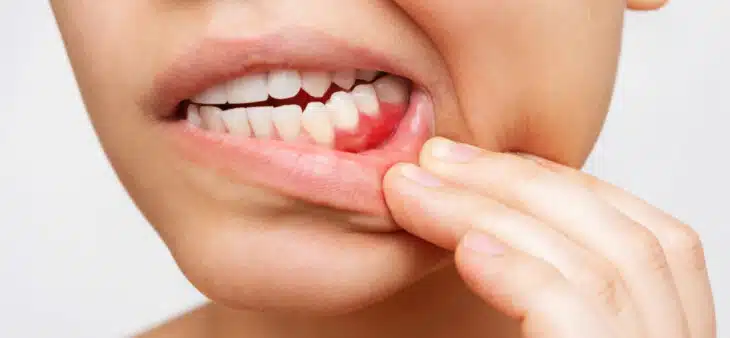
According to the CDC, 47.2% of Americans aged 30 and older have gum disease. This number skyrockets to 70.1% of adults over 65. Bleeding gums are a symptom of gum disease, but it can also be caused by other factors. If you have bleeding gums, it’s essential to see your dentist so they can determine the underlying cause.
In most cases, bleeding gums can be treated successfully with professional cleanings and at-home oral care. More severe cases may require dental treatment or surgery to restore your gums to good health. It is best to take preventative measures like regular professional cleanings to ensure your teeth and gums are healthy.
What Causes Bleeding Gums?
A common cause of bleeding gums is gingivitis, an inflammation of the gums usually caused by poor oral hygiene. When plaque and bacteria build up on teeth, they can calcify into tartar, irritating and inflaming the gums, causing them to bleed.
Other possible causes of bleeding gums include vitamin C deficiency, hormonal changes, certain medications, and diseases like leukemia. For most people, bleeding gums and gum disease in the early stages can be reversed with good oral hygiene habits and routine dental care.
However, if the issue persists, or is accompanied by other symptoms like bad breath, swollen and tender gums, or discomfort, see your dentist for an oral health evaluation.
3 Ways to Prevent Bleeding Gums
The cause of persistent bleeding gums should be diagnosed by your dentist. They can assess your symptoms and recommend a treatment plan to restore your oral health.
1. Monitor Your Diet
Foods high in sugar are bad for your teeth because bacteria use sugar to produce acids that destroy the tooth enamel, leading to cavities. Limit the intake of sugary and acidic foods to protect your tooth enamel and minimize plaque build-up, which can irritate your gums.
Some foods can benefit your gums, including oranges, spinach, kale, carrots, red peppers, lettuce, sweet potatoes, and green tea. Oranges, carrots, red peppers, and sweet potatoes provide vitamin C, which aids in collagen production to support the connective tissue in your gums.
Spinach, kale, and lettuce have vitamin K to help your blood clot and prevent excessive bleeding. Green tea, while not a food, has catechin, an antioxidant that reduces inflammation.
2. Brush and Floss Your Teeth
According to the American Dental Association, brushing your teeth twice a day and flossing your teeth at least once daily can help prevent bleeding gums. Gum disease is caused by plaque, a sticky film of bacteria that forms on your teeth.
If left unchecked, the plaque hardens and transforms into tartar, a substance that is much harder to remove. By brushing and flossing, you remove the plaque before it can harden, protecting your teeth and gums.
3. Visit a Dentist for a Professional Cleaning
You cannot remove tartar with brushing and flossing alone. During a professional cleaning, your dentist can remove tartar and other buildup from the teeth using a manual curette or ultrasonic scraper, helping to prevent gum inflammation and bleeding.
A dentist can identify early signs of gum disease and provide treatment to help keep the condition under control.
Contact A Dental Place to Schedule Your Dental Cleaning and Exam
If you notice bleeding gums when you brush, floss, and eat, contact A Dental Place to schedule an exam and professional cleaning. If you have signs of gum disease, our dentist may recommend more frequent professional cleanings or prescribe a chlorhexidine mouthwash to eliminate bacteria and reduce inflammation, swelling, and bleeding.
Our dental office also offers numerous treatments for gum disease, including scaling and root planing, to help eliminate tartar and bacteria and rejuvenate your smile.
